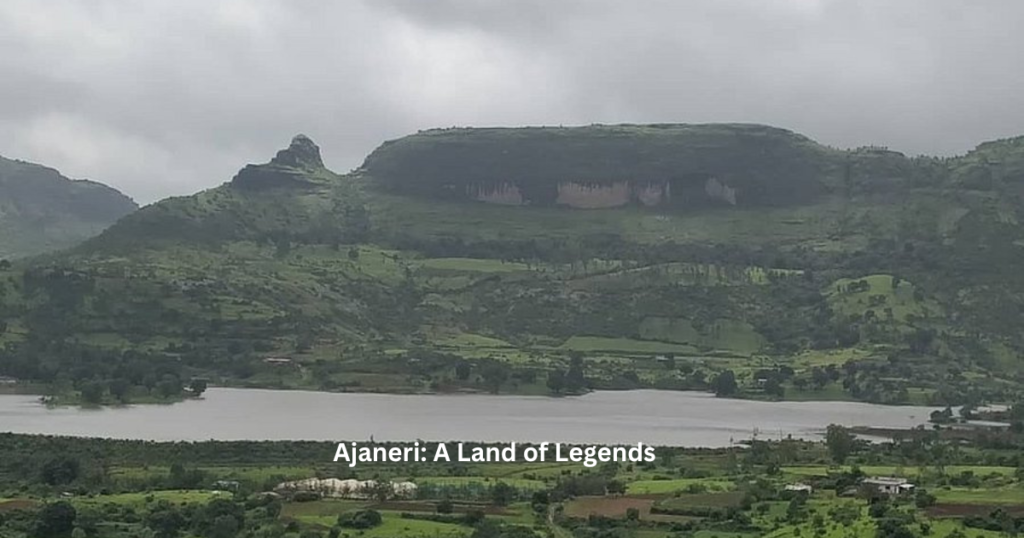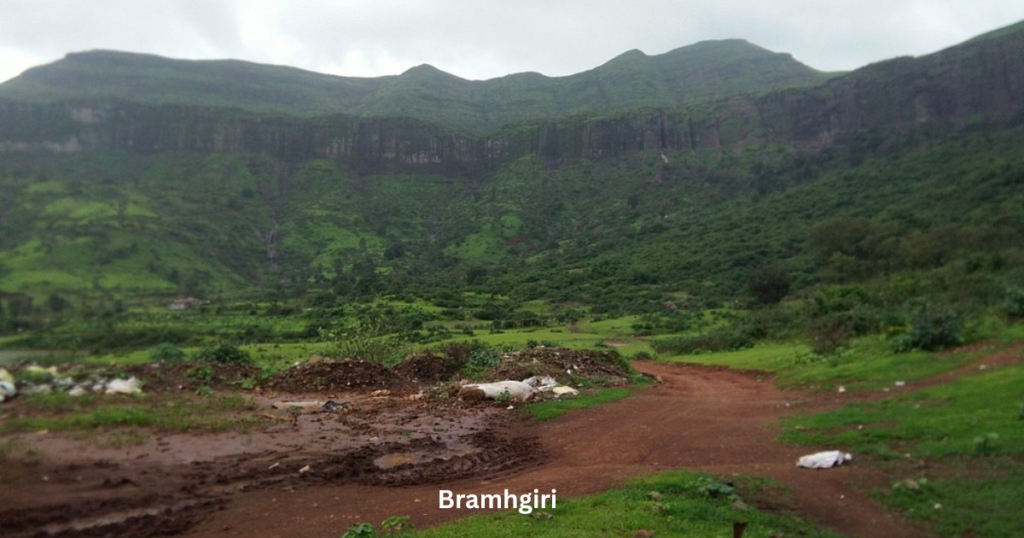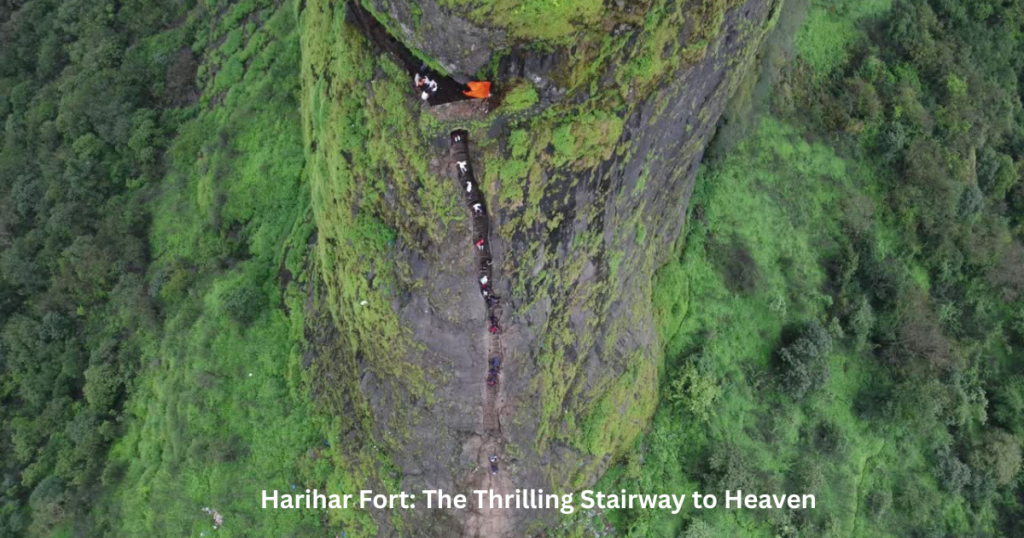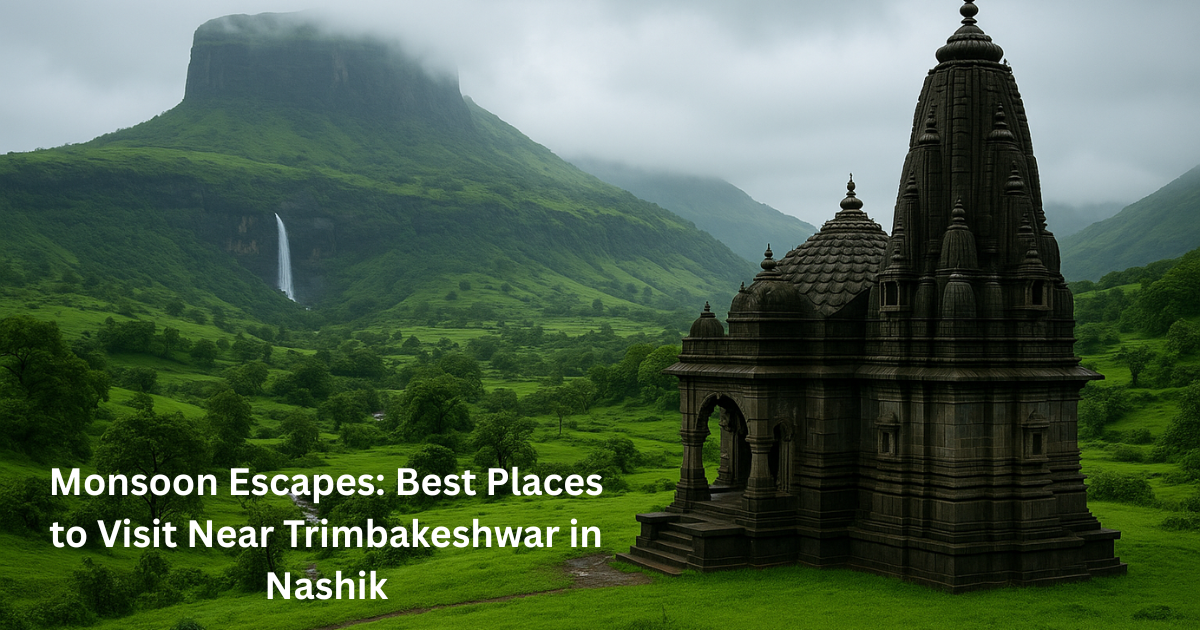Table of Contents
Nashik, often celebrated for its rich spiritual and cultural heritage, becomes a true paradise during the monsoon. The region around Trimbakeshwar transforms into a lush green haven, with misty mountains, gushing waterfalls, and an air of freshness. Whether you are a pilgrim visiting the sacred Trimbakeshwar Temple or a traveler looking to explore hidden gems, the rainy season opens up a world of beautiful experiences. Here’s a guide to the places to visit in Nashik near Trimbakeshwar in the rainy season, complete with travel tips and detailed insights.
1. Trimbakeshwar Temple
Your journey should start with the divine Trimbakeshwar Temple, one of the twelve sacred Jyotirlingas in India. Built in the 18th century by the Peshwa Balaji Baji Rao, this temple is a marvel of Hemadpanthi architecture, featuring intricate stone carvings and a majestic black basalt structure. The temple’s sanctum houses the three-faced linga symbolizing Brahma, Vishnu, and Shiva.
Travel Tip: Monsoon rains enhance the spiritual aura around the temple. Carry an umbrella or raincoat, as you might have to stand in queues outdoors.
How to Visit: Trimbakeshwar is about 30 km from Nashik city. You can hire a cab, take a bus, or drive yourself. Ample parking and local eateries are available.
2. Ajaneri Hills: Trek to the Birthplace of Lord Hanuman

Nestled between Nashik and Trimbakeshwar, Ajaneri Hills is a hidden paradise that beautifully blends mythology, trekking, and breathtaking landscapes. Believed to be the birthplace of Lord Hanuman, this serene destination attracts devotees, trekkers, and nature lovers alike.
Ajaneri: A Land of Legends
The name Ajaneri is derived from Anjani, the mother of Lord Hanuman. According to ancient texts, it was on these very hills that Anjani Devi gave birth to her divine son. Because of this strong mythological connection, Ajaneri holds deep religious significance for devotees of Hanuman.
Atop the hill, you’ll find the Anjani Mata temple, a peaceful shrine where pilgrims offer prayers. The tranquil energy of the place, surrounded by hills and clouds, makes it feel otherworldly.
The Ajaneri Trek Experience
Trekking to Ajaneri Hills is an exciting yet beginner-friendly adventure. The trek is about 2–3 kilometers one way, making it ideal for families, casual trekkers, and pilgrims.
The trail begins with a straightforward walk through green fields and gradually moves to rocky terrain. Along the way, trekkers are greeted by:
- Freshwater ponds,
- Small caves said to be used by ancient sages,
- And panoramic views of the lush Sahyadri ranges.
During the monsoon and early winter months, the hills are covered in a vibrant green carpet, dotted with colorful wildflowers. The cool breeze, chirping birds, and misty atmosphere create a magical trekking experience.
At the top, apart from the Anjani Mata temple, you’ll also find ancient Jain caves and carvings, showcasing the historical significance of the region.
Tips for Visiting Ajaneri Hills
- Best Time to Visit: July to February. (Monsoon adds extra beauty but be cautious of slippery paths.)
- Trek Difficulty: Easy to Moderate.
- Footwear: Good grip trekking shoes are recommended.
- Carry: Water bottles, light snacks, and a raincoat if visiting during the monsoon.
- Start Early: Morning treks offer cooler temperatures and clearer views
Why You Should Visit Ajaneri
Whether you are seeking divine blessings, a peaceful trek, or a refreshing getaway near Nashik, Ajaneri Hills will not disappoint. It’s one of those places where mythology comes alive and nature heals the soul. Standing on the ancient land where Lord Hanuman is believed to have been born, looking over the endless green landscape, you’ll feel a powerful sense of peace and wonder.
Architecture and Nature: You’ll find ancient caves, a small Anjaneri temple, and scenic viewpoints along the trail. The monsoon mist adds a magical touch to the entire trek.
Travel Tip: Start early in the morning to avoid slippery paths in heavy rain. Good trekking shoes and water bottles are a must.
3. Bramhgiri Hill: The Birthplace of the Godavari River

Located about 28 kilometers from Nashik city, Bramhgiri is not just a scenic hill — it is revered as the birthplace of the sacred Godavari River, often called the Ganga of the South.
According to Hindu mythology, it was here that Sage Gautam performed penance to bring the river Ganga down to Earth. The river, manifesting as Godavari, emerged from a stone cow’s mouth, which can still be seen today at Gangadwar.
The Bramhgiri trek is a fulfilling experience. The climb involves steep steps — nearly 750 of them — carved into the rocky hill. The recently improved steps and railings make the ascent easier and safer for pilgrims and trekkers alike. Along the way, the panoramic views of Nashik’s lush landscape add a breathtaking touch to the spiritual journey.
Brahmagiri Hill, located right behind the Trimbakeshwar Temple, is a sacred mountain from where the holy Godavari River originates. The climb involves around 750 steps, but the breathtaking view from the top is worth every effort. During the rainy season, waterfalls cascade down the slopes, and the surroundings burst into life.
At the summit, visitors find several temples, including the Bramhagiri Temple, dedicated to Lord Shiva. The peaceful environment, the chill in the air, and the sight of sadhus meditating make it a place where time seems to pause.
Architecture: Along the way, you’ll encounter rock-cut steps and ancient structures linked to Hindu mythology.
Travel Tip: Carry light snacks, wear comfortable shoes, and be cautious while climbing during rains as the steps can become very slippery.
4. Gangadwar: Where Godavari Touches Earth
Halfway up Bramhgiri Hill is Gangadwar, where a sacred kund (water tank) marks the spot where the Godavari first appeared on Earth. The cow-shaped stone spout from which the river flows is deeply symbolic and revered by devotees.
Pilgrims often perform rituals here, seeking blessings and purification. The soothing sound of flowing water, coupled with the chants of pilgrims, creates a deeply spiritual atmosphere.
Interestingly, in ancient times, it was believed that a pilgrimage to Gangadwar held as much merit as a pilgrimage to Gangotri in the Himalayas.
How to Visit: The path to Gangadwar is the same as Brahmagiri but requires only a moderate hike, making it accessible even to those who cannot climb to the summit.
Travel Tip: Take your time to enjoy the misty scenery and the cool breeze; the views are spectacular during monsoon.
Tips for Visiting Bramhgiri and Gangadwar
- Best Time to Visit: July to February. Monsoons bring lush greenery but the steps can be slippery.
- Trek Difficulty: Moderate. Suitable for beginners with basic fitness.
- Footwear: Comfortable trekking shoes are recommended.
- Timings: Start early morning to avoid the harsh afternoon sun.
- Nearby Attractions: Trimbakeshwar Jyotirlinga Temple (a must-visit if you’re in Nashik).
5. Harihar Fort: The Thrilling Stairway to Heaven

In the heart of Maharashtra’s Sahyadri range lies Harihar Fort — a spectacular structure known for its vertical rock-cut steps, breathtaking views, and adventurous trek. For those who seek excitement mixed with history and nature, Harihar Fort Nashik is a must-visit!
The Fascinating History of Harihar Fort
Harihar Fort, also known locally as Harshagad, dates back to the Yadava dynasty and later played a crucial role during the Maratha Empire. It was strategically built to guard the trade route through Gonda Ghat.
Today, its remains — sturdy stone walls, water cisterns, and temple ruins — tell stories of battles, bravery, and ancient craftsmanship.
The Legendary Climb: A Trekker’s Dream
What makes Harihar Fort truly unique are its steep, almost vertical stone-carved steps. These iconic steps are not just steep — they’re at a 75 to 80-degree angle, giving you the thrill of literally climbing a wall!
Handholds and foot holes are carved into the rock, making the climb possible and surprisingly manageable if you stay calm and careful. Once you conquer the staircase, a small gate leads you into the fort premises.
From the top, you get 360° panoramic views of lush valleys, neighboring forts like Bhaskargad and Fani Hill, and endless green landscapes that stretch into the horizon — especially magical during the monsoon.
Key Highlights of Harihar Fort
- The Vertical Steps: The highlight of the trek and a bucket-list experience for adventure enthusiasts.
- Meda Temple: A small temple dedicated to Lord Hanuman and Shiva at the top.
- Rock-Cut Water Cisterns: Ancient rainwater storage systems that show the fort’s historic planning.
- Sunrise/Sunset Views: Stunning scenes that reward your effort, perfect for photography.
Trekking Details for Harihar Fort
- Base Village: Nirgudpada (also called Kotamvadi).
- Trek Difficulty: Moderate to Difficult.
- Trek Duration: 1.5 to 2 hours one way.
- Best Time to Visit: Monsoon (July to September) for lush greenery or winter (October to February) for clear skies.
- Entry Fee: Usually free, but sometimes local villagers charge a nominal maintenance fee.
Things to Carry:
- Good trekking shoes with strong grip.
- Water bottles (at least 2 liters).
- Energy bars and light snacks.
- Rain gear (during monsoon).
- First-aid kit and basic trekking gear.
Harihar Fort is not just another trek — it’s an adventure of a lifetime. The climb might look intimidating, but it’s safe for those who take it slow and steady. Once at the top, the sense of accomplishment, combined with the stunning scenery, makes every drop of sweat worth it.
Architecture: Harihar Fort dates back to the Yadava dynasty and features an interesting architecture where the steps seem almost vertical.
How to Visit: The base village for the trek is Nirgudpada, accessible by road from Nashik or Trimbakeshwar. From there, it’s a 2-3 hour trek to the summit.
6. Vaitarna Dam
Located about 30 km from Trimbakeshwar, Vaitarna Dam is a picturesque spot perfect for a peaceful monsoon getaway. The dam creates a vast serene lake surrounded by rolling hills. In the rainy season, the landscape looks nothing less than a painting, with mist hanging over the water and hills wearing a green velvet.
Architecture: Built during the British era, Vaitarna Dam showcases sturdy colonial engineering and forms an essential part of the region’s water supply system.
Travel Tip: Ideal for a relaxed picnic or a photography session. Early mornings and late afternoons offer the best light and weather.
Travel Tips for Visiting Nashik and Trimbakeshwar in Monsoon
- Road Conditions: Monsoon can cause potholes and slippery roads. Drive cautiously or hire experienced drivers.
- Clothing: Wear quick-dry clothes and pack extra pairs. Waterproof footwear is highly recommended.
- Timing: Start your day early to make the most of the daylight, especially since rain can delay your plans.
- Local Food: Enjoy hot bhajiyas (fritters), misal pav, and chai from local vendors – nothing beats spicy snacks in rainy weather.
- Stay Options: There are many hotels and guesthouses near Trimbakeshwar, ranging from budget stays to comfortable lodges. Book early during weekends and festivals.
- Respect Nature: Avoid littering and be respectful of local customs, especially at religious sites.
Conclusion
Exploring places to visit in Nashik near Trimbakeshwar in the rainy season is a soul-satisfying experience. From sacred temples and mystical rivers to adventurous treks and serene landscapes, this region has something for everyone. Whether you seek spirituality, adventure, or simply the romance of monsoon rain, Nashik and Trimbakeshwar will leave you spellbound.
Pack your bags, embrace the rain, and get ready for a monsoon journey like no other!
